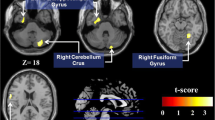Abstract
This chapter focuses on ventilatory response to hypercapnia (VRH) in patients with dementia with Lewy bodies (DLB). VRH is a rise in ventilation induced by increase in PCO2. In our study, VRH was impaired in all examined DLB patients, while that of Alzheimer’s disease (AD) and healthy elderly patients was normal. The mean VRH in DLB patients was significantly lower compared with Alzheimer’s disease and healthy elderly patients. Impaired VRH can be observed also in the prodromal and mild stages of DLB. Hypercapnia primarily stimulates the central chemoreceptors, putatively located in the medulla oblongata. Thus, impaired VRH may be, in part, associated with the DLB lesions in the medulla oblongata. VRH is a promising diagnostic method for differentiating DLB from AD. Furthermore, it is important to bear in mind that DLB patients are susceptible to respiratory compromise and have risk of poor outcome due to respiratory complications.
Access this chapter
Tax calculation will be finalised at checkout
Purchases are for personal use only
Similar content being viewed by others
References
Horimoto Y, Matsumoto M, Akatsu H, et al. Autonomic dysfunctions in dementia with Lewy bodies. J Neurol. 2003;250:530–3.
Thaisetthawatkul P, Boeve BF, Benarroch EE, et al. Autonomic dysfunction in dementia with Lewy bodies. Neurology. 2004;62:1804–9.
Fujishiro H, Iseki E, Nakamura S, et al. Dementia with Lewy bodies: early diagnostic challenges. Psychogeriatrics. 2013;13:128–38.
Yoshita M, Taki J, Yokoyama K, et al. Value of 123I-MIBG radioactivity in the differential diagnosis of DLB from AD. Neurology. 2006;66:1850–4.
Yoshita M, Arai H, Arai H, et al. Diagnostic accuracy of 123I-meta-iodobenzylguanidine myocardial scintigraphy in dementia with Lewy bodies: a multicenter study. PLoS One. 2015;10(3):e0120540.
Allan LM, Ballard CG, Allen J, et al. Autonomic dysfunction in dementia. J Neurol Neurosurg Psychiatry. 2007;78:671–7.
Mizukami K, Homma T, Aonuma K, et al. Decreased ventilatory response to hypercapnia in dementia with Lewy bodies. Ann Neurol. 2009;65:614–7.
Guarnieri B, Adorni F, Musicco M, et al. Prevalence of sleep disturbances in mild cognitive impairment and dementing disorders: a multicenter Italian clinical cross-sectional study on 431 patients. Dement Geriatr Cogn Disord. 2012;33:50–8.
Hibi S, Yamaguchi Y, Umeda-Kameyama Y, et al. Respiratory dysrhythmia in dementia with Lewy bodies: a cross-sectional study. BMJ Open. 2013;3(9):e002870.
Sharma G, Goodwin J. Effect of aging on respiratory system physiology and immunology. Clin Interv Aging. 2006;1:253–60.
Kronenberg RS, Drage CW. Attenuation of the ventilatory and heart rate responses to hypoxia and hypercapnia with aging in normal men. J Clin Invest. 1973;52:1812–9.
Takahashi S, Mizukami K, Yasuno F, et al. Depression associated with dementia with Lewy bodies (DLB) and the effect of somatotherapy. Psychogeriatrics. 2009;9:56–61.
Takahashi S, Mizukami K, Arai T, et al. Ventilatory response to hypercapnia predeicts dementia with Lewy bodies in late-onset major depressive disorder. J Alzheimers Dis. 2016;50:751–58.
Chokroverty S, Sharp JT, Barron KD. Periodic respiration in erect posture in Shy-Drager syndrome. J Neurol Neurosurg Psychiatry. 1978;41:980–6.
Tsuda T, Onodera H, Okabe S, et al. Impaired chemosensitivity to hypoxia is a marker of multiple system atrophy. Ann Neurol. 2002;52:367–71.
Onodera H, Okabe S, Kikuchi Y, et al. Impaired chemosensitivity and perception of dyspnoea in Parkinson’s disease. Lancet. 2000;356:739–40.
Seccombe LM, Giddings HL, Rogers PG, et al. Abnormal ventilatory control in Parkinson’s disease--further evidence for non-motor dysfunction. Respir Physiol Neurobiol. 2011;179(2–3):300–4.
Haji A, Takeda R, Okazaki M. Neuropharmacology of control of respiratory rhythm and pattern in mature mammals. Pharmacol Ther. 2000;86:277–304.
Boudinot E, Emery MJ, Mouisel E, et al. Increased ventilation and CO2 chemosensitivity in acetylcholinesterase knockout mice. Respir Physiol Neurobiol. 2004;140:231–41.
Mulkey DK, Stornetta RL, Weston MC, et al. Respiratory control by ventral surface chemoreceptor neurons in rats. Nat Neurosci. 2004;7:1360–9.
Guyenet PG, Stornetta RL, Bayliss DA. Retrotrapezoid nucleus and central chemoreception. J Physiol. 2008;586:2043–8.
Richerson GB. Serotonin neurons as CO2 sensors that maintain pH homeostasis. Nat Rev Neurosci. 2004;5:449–61.
Corcoran AE, Hodges MR, Wu Y, et al. Medullary serotonin neurons and central CO2 chemoreception. Respir Physiol Neurobiol. 2009;168:49–58.
Hishikawa N, Hashizume Y, Yoshida M, et al. Clinical and neuropathological correlates of Lewy body disease. Acta Neuropathol. 2003;105(4):341–50.
Benarroch EE, Schmeichel AM, Dugger BN, et al. Dopamine cell loss in the periaqueductal gray in multiple system atrophy and Lewy body dementia. Neurology. 2009;73:106–12.
Mizukami K. Dementia with Lewy bodies and depressive state. Seishin Shinkeigaku Zasshi. 2012;114(3):289–96. [Article in Japanese].
Author information
Authors and Affiliations
Corresponding author
Editor information
Editors and Affiliations
Rights and permissions
Copyright information
© 2017 Springer Japan KK
About this chapter
Cite this chapter
Mizukami, K. (2017). Ventilatory Response to Hypercapnia in Dementia with Lewy Bodies. In: Kosaka, K. (eds) Dementia with Lewy Bodies. Springer, Tokyo. https://doi.org/10.1007/978-4-431-55948-1_15
Download citation
DOI: https://doi.org/10.1007/978-4-431-55948-1_15
Published:
Publisher Name: Springer, Tokyo
Print ISBN: 978-4-431-55946-7
Online ISBN: 978-4-431-55948-1
eBook Packages: MedicineMedicine (R0)




